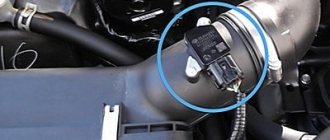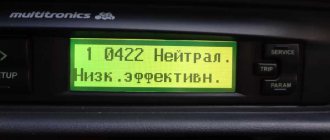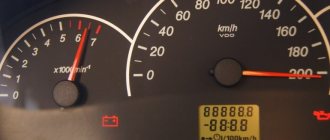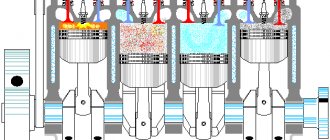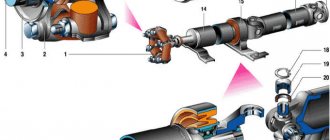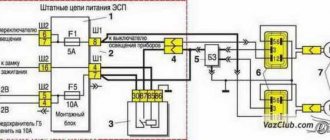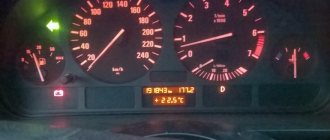If the VAZ 2105 discharges , then one of three elements may be “to blame”: the generator, the voltage regulator, and the connections between them. Determining “who is to blame” can be very simple, even without additional devices.
In today’s article we will look at the reasons and ways to solve the problem of rapid discharge and lack of battery charge on a VAZ 2105 car.
Reasons for the battery not charging
To start the engine and proper operation of the ignition system and other electrical circuits of the VAZ 2105, it is necessary to have DC voltage in the on-board network. When the engine is not started, the battery maintains the proper voltage. After the engine starts, the car's generator charges the battery and maintains the on-board voltage at 13.6-14.2 V.
Checking the battery charge using a voltmeter
Regardless of engine speed, the output voltage at the generator remains constant. A relay-regulator is responsible for this, which changes the voltage of the generator excitation circuit. If the voltage rises above the permissible level, the winding current decreases, reducing the output voltage. And vice versa.
If the VAZ 2107 has lost charging, the reasons may be as follows:
- Generator malfunction;
- break or poor contact in the excitation network or generator output voltage;
- broken generator belt.
Restoring normal operation of the generator should begin by determining the reason for the lack of battery charge.
VAZ 2105 generator malfunction
Experts suggest that on a VAZ-2107 with an injector, the standard generator is 5142.3771 (eight). It has one very important feature: it produces more current - not 55A per hour, like other generators, but about 80-90 A. This is due to the properties of the injector, which requires more electricity (but also has a higher power density).
Car battery current leakage
Experts advise checking the generator for malfunctions in the following order:
- inspect the diodes that supply electricity to the excitation winding of the generator (if they are burned out, they should be replaced with new ones);
- use a tester to measure the voltage level in the current-carrying circuit (if its value is less than 12 V, then there may be a short circuit, which means the wiring is overheating).
Break or poor contact in the excitation network or generator output voltage;
Often, symptoms that indicate characteristics of a faulty generator can also appear as a result of completely different problems. As an example, poor contact in the fuse socket of the generator field winding circuit will indicate a generator malfunction. The same suspicion may arise due to burnt contacts in the ignition switch housing. Also, the constant lighting of the generator malfunction indicator lamp can be caused by a breakdown of the relay; the blinking of this switching lamp may indicate a generator malfunction.
Broken alternator belt
As a rule, the generator belt breaks due to its wear. While working, it is under a fairly decent load, and although modern belts are made of very durable materials, over time the following appear:
- abrasions;
- cracks;
- teeth wear off;
- the edges are fraying.
If you find at least one of these signs, then do not delay replacing it; the consequences will not take long to arrive.
A characteristic whistle can indicate that something is not right with the drive. This usually happens in wet weather. It happens that it disappears while driving, but sometimes it doesn’t. This occurs due to the weakening of the belt tension. Sometimes it is enough to use tension mechanisms to tighten the belt more, but, as a rule, it needs to be replaced. You can replace the drive yourself - this is not a difficult job, or you can contact a service station. It's up to you, but he should be fine. If the alternator belt breaks, don’t worry. This is a non-critical failure. It’s just that now, when you start driving, the battery will stop charging, and the systems will begin to intensively consume battery energy.
why does the VAZ 2105 generator not charge the battery?
The VAZ 2104 car has a voltmeter and a warning lamp on the instrument panel to monitor the battery charge. In cases where the voltmeter is not in the green zone and the control lamp is on, this indicates that the VAZ 2104 is not charging the battery. This could be due to several reasons. First of all, the fuse in the battery charging circuit and the reliability of its fixation in the mounting block are checked. The second thing you need to pay attention to when troubleshooting is the alternator drive belt. The belt should not be worn, twisted and have the required tension. The deflection of the alternator belt should normally be 10-15 mm when pressed by hand.
In addition, it is worth inspecting the generator drive pulley, which may also be worn out, and the belt will simply slide along its surface without turning the generator rotor. In such cases, both the pulley and the belt must be replaced. Next, you need to check the output voltage from the generator, and if it is normal and shows 13.5 -14. 2V, then check the wire from the generator to the battery for integrity and reliability of its connection. The terminals on the battery itself may be oxidized or may not have reliable contact with the battery terminals.
The oxidized terminals are cleaned (a solution of soda and water), and the unreliable contact is tightened. Further, the reason why the VAZ 2104 does not charge the battery may be the generator brushes, which either have extreme wear or are stuck in the brush holder guides. Worn brushes are replaced and jamming is eliminated. In addition, the slip rings may be worn out and the brushes cannot completely lie on the rings, so there is no reliable contact in the excitation circuit. Also, the reason for the lack of charging may be a faulty relay-regulator, combined with the brush assembly. In such cases, the relay-regulator along with the brush assembly must be replaced.
The lack of charging can be affected by an interturn short circuit, a short to ground or a break in the stator winding, as well as a break in the generator excitation circuit. In the generator, the diodes of the rectifier unit (popularly called a horseshoe) can also fail, as well as a short circuit or breakdown of one of the additional diodes. Read also, other reviews The fact that there is a current leak is obvious, since the named devices are working properly. After you have removed the ignition key, you can determine and measure the current leakage with a microammeter at the fuse terminals by removing them one by one. By turning the key to the 1st position, you can also check the current and compare it with the rated one for the consumers connected to the fuse.
Car modifications
VAZ-2105 . The base model was produced in 1979 with a 1.29-liter carburetor engine producing 63.6 horsepower. It was equipped with a 4-speed gearbox.
VAZ-21050 . The same model of the five, but with a 5-speed gearbox.
VAZ-21051 . Modification with a VAZ-2101 carburetor engine with a volume of 1.2 liters and a power of 58.7 horsepower, a 4-speed gearbox as in the basic version.
VAZ-21053 . Modification with a VAZ-2103 engine with a volume of 1.45 liters and a power of 71.4 horsepower. It was equipped with both 4 and 5-speed gearboxes.
VAZ-21053-20 . Modification with a VAZ-2104 injection engine with distributed injection, volume 1.57 liters and 82 horsepower. The gearbox is 5-speed.
VAZ-21054 . A special modification for the needs of no less special services, such as the traffic police, the Ministry of Internal Affairs and the FSB. It was equipped with a VAZ-2106 carburetor engine with a volume of 1.57 liters and a power of 80 horsepower. In addition, an additional gas tank and battery were installed.
VAZ-21054-20. Another special modification, but with a more powerful VAZ-21067 engine with distributed injection, 82 horsepower, which meets the Euro-3 environmental standard. The gearbox is 5-speed.
Diagram of the battery charging circuit on the VAZ-2107
The battery charging circuit diagram for the VAZ-2107 is the same as for other passenger cars. The mechanism of its action is as follows:
- The battery is connected by its “negative” terminal to the body using a copper busbar.
- The entire electrical system is connected to the positive terminal of the battery using two buses:
- the first tire goes to the starter;
- the second bus is to the generator.
- The “positive” terminal of the generator transmits voltage:
- on the fuse block;
- to the ignition switch.
- From the ignition switch, electricity is transmitted to the mounting block, which houses fuses (the one that protects this conductive circuit is marked “F10”).
- Voltage is supplied from the fuses:
- to the “Charge Level Signal” control lamp (it is intended to notify you that the battery is insufficiently charged);
- on a voltmeter, which shows digital voltage readings in a current-carrying circuit.
- The next stage in the battery charging circuit is the transfer of current to:
- fuse box;
- generator terminal 61 (brush assembly).
As you can see, a malfunction in this battery charging circuit can appear almost anywhere. For example, the contact breaks down, as a result of which the generator will stop efficiently charging the vehicle’s battery.
What to do if the battery is boiling
The lamp goes out, the voltmeter needle goes to the right into the red sector, and there is a sharp “chemical” smell in the cabin. At idle, the needle is in the green sector, but as soon as you accelerate, it goes all the way to the right. This indicates that the voltage regulator (chocolate) has failed . If this happens, moving on is more expensive! All the electrical equipment of the car may burn out, and the battery will get damaged, the electrolyte will “boil”, the plates may become warped. To get to the repair site, you can temporarily turn off the generator by removing the wire from terminal “61” of the generator. You can drive for quite a long time on a good battery, just don’t forget to turn off unnecessary electrical appliances - heater fan, heated rear window, radio, etc. Headlights or running lights will have to be left.
Voltage too high (overcharge)
This article describes a simple way to determine if the alternator, voltage regulator, or connections between them are faulty. How to repair all this in the next article .
It turned out that the wire on the device in the plug had become loose and did not connect, the lamp came on when I fixed it and the charge started
I turn on the ignition, the right headlight is on and there is no charging
Features of the generator device
The generator housing consists of two covers made of aluminum alloy, tightened with four bolts and nuts, between which a round stator core is clamped. Rotor bearings are installed in the covers: the front one is in a through bearing, the rear one is in a blind seat of the cover. The rotor rotates inside the stator and housing on two bearings. The front end has a slot for a key and a thread for the fan nut. An adjusting washer is installed between the front rotor and the front bearing, which is often forgotten to be installed when repairing the generator. At the rear end of the rotor shaft, in front of the rear bearing, two copper slip rings are pressed in, insulated from the shaft and connected to the ends of the field winding.
A BPV6-50 rectifier is installed to the inside of the back cover. It consists of two horseshoe-shaped aluminum buses insulated from each other, into which three silicon diodes (valves) of the BA-20 type are pressed. The internal bus is isolated from the housing, but is connected to the generator terminal bolt “30”, while the other has contact with ground. The legs of the diodes in pairs from each bus are bolted to the ends of the phase windings of the stator, and their other ends are connected together - a star connection. In the G 222 generator, a wire goes from this point to a terminal on the back cover, from which a wire goes to terminal “85” of the RS-702 type charge indicator relay. There are no wires at 37.3701 from the common point of the phase windings.
Brushes are pressed to the contact rings of the rotor by springs, one of which is connected to terminal “B”, and the second to terminal W of the voltage regulator installed on the brush assembly in the upper rear part of the generator. In 37.3701 there are three diodes connected at one end to the phase windings, and the second are connected to one point, the wire from which goes to the regulator relay terminal Sh and terminal “61” on the rear surface of the generator. The diodes are connected in such a way that they pass positive half-cycles to pin “61”.
The electronic voltage regulator is non-separable and since 1996 has been installed in a metal case riveted to the brush holder. A capacitor is mounted between the housing and terminal “30”.
Generator connection diagram
Device Description
On the VAZ 2105, generator units G 222 were first installed, and since 1987, model 37.3701 began to be installed. The device is a 3-phase electromechanical machine with an electromagnetic exciter that converts the mechanical energy of a rotating rotor into electrical energy. Rotations are transmitted to the rotor through the VAZ generator drive belt, mounted on the crankshaft pulley. The unit is located on the right in the engine compartment in front of the engine.
Device design diagram
In the design of the generator unit:
- stator;
- rotor;
- graphite brushes of the VAZ generator;
- voltage regulator;
- rectifier;
- relay-regulator.
Generator connection diagram
The maximum output current of the generator unit is 55 (45) Amperes. The operating voltage is 13.6-14.6 Volts. Right rotation.
Sometimes, after repair or tuning, generators from a VAZ 21053 or 2108 are installed on models manufactured before 1987. If the connection is incorrect and the circuit is violated, the battery will not charge.
How to solve a problem
The procedure for finding the reason why the generator does not charge the battery:
- Check to see if the accessory drive belt (or alternator belt) is broken. If the belt is intact, check its tension.
- If the belt tension is normal, but the warning light is still on, check that the wiring harness block and the positive wire terminal are securely connected to the generator. Please note that wires may be broken or broken within the insulation.
- Check the reliability of the wire connections to the battery terminals.
- Check the integrity of the generator fuse in the engine compartment mounting block. Replace the blown fuse if necessary.
- If, after all the measures taken, the charging lamp continues to light while the engine is running, then most likely the generator is faulty (for example, the voltage regulator is faulty
VAZ 2107 The generator does not charge. The control lamp does not work.
Similarly, you can continue checking with the ignition on. A melted positive wire is caused by a large current, such as the one that goes to the starter. Current is supplied to the main terminals of the starter through a thick wire, bypassing the fuses (from the fuse, current through a thin wire goes only to the starter relay drive). Check the thick wire that goes to the starter, there is a terminal in the shape of the letter “G”. — If the nut on the terminal is loose, then the terminal may tilt and, with a strong impact or shaking, touch the engine block, and the battery jumper would immediately burn out (it is unlikely that the wire itself).
If dirt has accumulated there, then a current leak may occur, which will negate the charging of the battery. If everything is in order with the terminal of the thick wire to the starter, then I would remove the starter itself, its relay and check, clean and file the terminal of the main contacts and the relay contacts themselves. Maybe somewhere in the starter it periodically shorts out, maybe it doesn’t turn off completely, and there’s a leak through it. Since the starter has been removed, it wouldn’t hurt to send it for diagnostics. Sorry if I'm wrong and distracting with my guesses.
Fuses and relays VAZ 2104, 2105
The mounting fuse block for VAZ 2104 and 2105 (carburetor, injector) is located in the engine compartment on the right side and is mounted on the front panel. This block is closed on top with a lid on which symbols are indicated with the purpose of the relay, numbers of fuses and protected circuits. Most car electrical circuits are protected by fuses that are installed in the mounting block.
| Fuse no. | Current strength, A | Protected Circuits |
| F1 | 10 | Tail lights (reversing lights). Heater motor Warning lamp and rear window heating relay (winding) |
| F2 | 10 | Electric motors for the windshield wiper and washer pump. Windshield wiper relay |
| F3 | 10 | Spare |
| F4 | 10 | Spare |
| F5 | 20 | Rear window heating element and heating relay (contacts) |
| F6 | 10 | Cigarette lighter. Portable lamp socket |
| F7 | 20 | Sound signals and relay for turning on sound signals. Engine cooling fan motor and motor switch relay (contacts) |
| F8 | 10 | Direction indicators in hazard warning mode. Switch and relay-interrupter for direction indicators and hazard warning lights in emergency mode |
| F9 | 7.5 | Generator voltage regulator (on vehicles with G-222 generator) |
| F10 | 10 | Turn indicators in turn signal mode and corresponding indicator lamp. Turn signal interrupter relay. Turn signal indicator Tachometer Fuel level indicator. Coolant temperature gauge. Voltmeter. Fan motor activation relay (winding). Battery charge indicator lamp. Indicator lamps for fuel reserve and parking brake activation. Warning lamps for emergency drop in oil pressure and insufficient brake fluid level. Indicator lamp for turning on the parking brake. Indicator lamp for covering the carburetor air damper (for a carburetor engine). Electric fan thermal switch. Carburetor pneumatic valve control system Generator excitation winding (generator 37.3701) |
| F11 | 10 | Rear lights (brake lamps). Body interior light |
| F12 | 10 | Right headlight (high beam). Winding of the relay for turning on the headlight cleaners (with the high beams on) |
| F13 | 10 | Left headlight (high beam). Indicator lamp for high beam headlights |
| F14 | 10 | Left headlight (side light). Right rear light (side light). License plate lights. Engine compartment lamp Indicator lamp for turning on side lights |
| F15 | 10 | Right headlight (side light). Left rear light (side light). Cigarette lighter lamp. Instrument lighting lamp. Glove compartment lamp |
| F16 | 10 | Right headlight (low beam). Winding of the relay for turning on the headlight cleaners (with the low beam on) |
| F17 | 10 | Left headlight (low beam) |
Why the VAZ 2105 battery is not charging: reasons, diagnostics, troubleshooting
If the VAZ 2105 discharges , then one of three elements may be “to blame”: the generator, the voltage regulator, and the connections between them. Determining “who is to blame” can be very simple, even without additional devices.
In today’s article we will look at the reasons and ways to solve the problem of rapid discharge and lack of battery charge on a VAZ 2105 car.
The VAZ 2105 battery has boiled - what to do?
There are several reasons why batteries boil. Let's consider them in order of importance:
- Recharging the battery
- Short circuit of cans
- Sulfation of plates
- Electrical system overload
- Battery polarity reversal
If the battery boils on your car while driving, you must immediately take the following steps:
- turn off the engine;
- open the hood to provide air flow; if the battery has a jacket, remove it; Allow the battery to cool to a temperature below 40 degrees Celsius (easily determined by touching it with your hand); close the hood, start the car and drive to the nearest gas station;
- purchase distilled water and top up to the required electrolyte level;
- if the battery is maintenance-free, topping up can be done through the gas outlet;
- if the repair kit contains a multimeter, measure the voltage on the battery with the engine running; if the voltage exceeds 15 Volts, disconnect the thick wire of the generator, carefully insulating it and securing it to the nearest body element;
- Continue driving to the parking or repair site, turning off, if possible, all additional comfort devices (stove, car radio, air conditioning and others).
Symptoms of a problem
So, in case of low voltage, the battery simply will not charge. That is, in the morning you will not be able to start the car, the lights on the dashboard may not even light up, or troubles will arise while driving. For example, dim headlights at night, unstable operation of the electrical system (problems with electrical appliances - wipers, heaters, radio, etc.).
In case of increased voltage, there is a high probability of a decrease in the electrolyte level in the battery banks, or its boiling. A white coating may also appear on the battery case. When overcharging, the battery may behave inappropriately.
Signs, malfunctions, repair of generator and voltage regulator
In addition, you can also identify the following signs of a faulty voltage regulator (in some cases, some of them may or may not be present, it all depends on the specific situation):
- when the ignition is turned on, the control light on the dashboard does not light up (although this may be a sign of other malfunctions, for example, that it has burned out, the contact has fallen out, and so on);
- after starting, the battery indicator on the dashboard does not go out, that is, there are obvious malfunctions in charging the battery;
- the brightness of the headlights becomes dependent on the engine speed (you can check this somewhere in a deserted place by placing the car against a wall and accelerating - if the glow changes, then most likely the voltage regulator is faulty);
- the car stopped starting normally the first time;
- The battery is constantly discharged quickly;
- when the engine speed exceeds 2000 rpm, the indicators on the dashboard turn off;
- the dynamic characteristics of the car decrease, this is especially noticeable at high engine speeds;
- In some cases, the battery may boil.
Questions from readers
And now I would like to answer questions from our readers!
The lamp does not light, the voltmeter needle remains at zero when the ignition is turned on.
We check the wires on the generator to see if the wire has come loose from terminal “61”. If everything is normal there, you need to check whether there is a “plus” on this wire using a test lamp, an indicator screwdriver or a multimeter.
If there is a “plus” , we check the “tablet” (aka “chocolate”) and the generator. There is no “plus” - you will have to remove the instrument panel and check the lamp. Replace the burnt out one.
Let's start the engine . The control lamp should go out, the voltmeter needle goes into the green sector and is located from the middle to the right edge (photo). If everything is so, then most likely the generator is working normally .
The lamp does not light up, the voltmeter needle shows normal
Check fuse No. 10 in the mounting block. 99% of the time it will be burnt out. In this case, all other lamps on the instrument panel will also be de-energized. Replace it with the same one and test again. If the fuse burns out again, you need to look for the cause, that is, a short circuit. We check whether the wires from the generator are disconnected, whether the insulation is frayed somewhere, etc.
The lamp remains on or dims slightly
If you give it gas, it goes out at high speeds and lights up again when they decrease. The voltmeter needle is in the white sector and goes to the edge of the green when the speed increases. The generator output is faulty. The same conclusion if the lamp continues to light at any speed, and the voltmeter needle is in the white sector and even goes to red.
If the generator seems to be working, but the battery is gradually discharging, we will perform another check. We start the engine, turn on the heater fan and low beam, take the key to “10” and, loosening the negative terminal of the battery, remove it. An idling engine (about 900 rpm) should not stall. If the engine stops, put the terminal back in place and start it again. While holding the speed at 1200-1500, remove the terminal again. Has the engine stalled again? Then turn off the headlights, leave the heater fan on and repeat the test. Now the engine with the negative terminal disconnected from the battery continues to run. output works, but does not produce the required current; it needs to be repaired.
5.2.2 Battery does not charge
A car has two power sources - a battery and a generator. The battery is used to start the engine and to supply 12 V electric current to the starter and other consumers when the engine is not running. When the engine is running, the main source of current - the generator - provides electric current to all consumers, including the ignition system, and charges the battery.
If the red battery charging lamp is on on the dashboard, it means that current is not flowing from the generator to the on-board network and the battery’s energy reserves are being consumed. This supply is limited and depends on capacity. If the battery is fully charged, you can drive to the garage without a generator, but it is better to try to fix the problem on the spot.
1.
Check if the alternator drive belt is broken.
If the belt is intact, check its tension. Press the top of the belt with your thumb and see how much it bends. Normal tension is ensured when the belt deflects 10–15 mm.
Is the belt tension normal?
3.
Check whether the corresponding fuse has blown.
The location of the fuses and their ratings are indicated in this manual ( see subsection “Electrical equipment malfunctions” ), in the vehicle repair manual, in a separate electrical diagram, on the cover of the mounting block and on the fuses themselves.
4.
Replace the fuse.
Warning
Do not install fuses designed for a higher rated current: this can lead to damage to electrical equipment and even a fire.
Start the engine and check if the battery charging lamp goes out.
Has the charging light gone out?
6.
Check the wire going from the generator to the positive terminal of the battery. Two wires are connected to it: the thicker one connects the battery to the starter, the thin one connects to the generator. The wire may be broken, broken inside the insulation, or have oxidized or unreliable contacts. Correct the problem and start the engine.
8.
If, after taking the measures, the charging lamp continues to light up while the engine is running, then the possible cause of the malfunction lies in the generator itself. There may be several reasons, and to eliminate them it is better to use the help of a specialist, and you just have to hope that the energy reserve in the battery is enough to get to the car service center.
Experienced car enthusiasts can be recommended to check the generator voltage regulator.
The operation of the voltage regulator is to continuously automatically change the generator excitation current so that the generator voltage is maintained within specified limits when the generator speed and load changes.
Check on the car
To check, you must have a DC voltmeter with a scale of up to 15–30 V, accuracy class no worse than 1.0.
After 15 minutes of engine operation at medium speed with the headlights on, measure the voltage between terminal “30” and the generator ground. The voltage should be between 13.6–14.6 V.
If there is a systematic undercharging or overcharging of the battery and the regulated voltage does not fall within the specified limits, the voltage regulator must be replaced.
Checking the removed regulator
a) diagram for checking the exhaust voltage regulator before 1996. b) diagram for checking the exhaust voltage regulator after 1996.
The regulator (item 3), removed from the generator, is checked according to the diagram shown. It is better to check the regulator, which was used before 1996, together with the brush holder, since in this case you can immediately detect breaks in the brush leads and poor contact between the terminals of the voltage regulator and the brush holder.
Let's summarize:
As you can see, there are many reasons why the battery does not have charge. At the same time, a number of problems when the battery does not charge are common to different cars (for example, a VAZ 2107 is not charging or the battery of a foreign car is not charging). Moreover, some of them can be easily detected and eliminated with your own hands. The main thing is to determine why the battery is not charging, after which appropriate measures are taken.
Finally, we note that even ordinary car enthusiasts usually do not have problems with cleaning the terminals and restoring the integrity of wires and contacts. If the problem is with the generator, if you do not have the skills to repair it, it is only recommended to dismantle it yourself and then transfer the generator to a specialized service for repair. This will allow you to avoid common mistakes that are made when repairing a generator with your own hands, and also obtain a guarantee for the repaired device.
Source
No battery charge VAZ 2105
Re: Charging disappears. I accelerate the speed to 3500, it appears
Unread message Violent » Sun Jul 25, 2010 6:12:01 AM
Re: Charging disappears. I accelerate the speed to 3500, it appears
Re: Charging disappears. I accelerate the speed to 3500, it appears
Unread message Bars87 » Sun Jul 25, 2010 7:37:44 AM
It is categorically not recommended to do this - I know from my own experience, I have already burned an alarm unit in this way.
Is the alternator belt properly tensioned?
Re: Charging disappears. I accelerate the speed to 3500, it appears
Re: Charging disappears. I accelerate the speed to 3500, it appears
Re: Charging disappears. I accelerate the speed to 3500, it appears
Unread message megavolt » Sun Aug 15, 2010 21:48:32
Re: Charging disappears. I accelerate the speed to 3500, it appears
Unread message guest » Mon Aug 16, 2010 10:36:24
Re: Charging disappears. I accelerate the speed to 3500, it appears
Unread message dragon61 » Mon Nov 22, 2010 10:42:28
Re: Charging disappears. I accelerate the speed to 3500, it appears
Unread message from Olezhek » Mon Nov 22, 2010 10:48:09
People believe nothing so firmly as what they know least about, and no one speaks with such self-confidence as writers of all sorts of fables - for example, astrologers, fortune tellers, palmists. Religion, superstitions. Michel Montaigne
Re: Charging disappears. I accelerate the speed to 3500, it appears
Unread message dragon61 » Mon Nov 22, 2010 17:07:06
Re: Charging disappears. I accelerate the speed to 3500, it appears
Unread message by igor1c » Mon Nov 29, 2010 5:36:36 AM
oh how I also suffered with this crap, but FOUND FOUND. reason. The charge disappears because the terminals on the battery oxidize (visually, I personally don’t notice this), but after cleaning with sandpaper the charge appears, it’s also worth checking the ground (clean the wire terminal that goes to the body). Moreover, this happens to me once a month consistently, I coated the terminals with lithol so that they would not oxidize - to no avail. Only periodic cleaning of the terminals helps.
